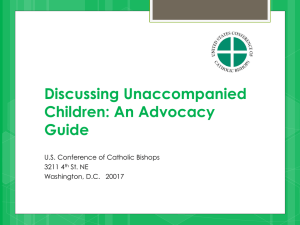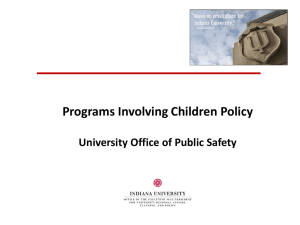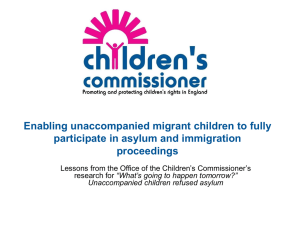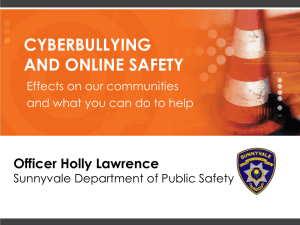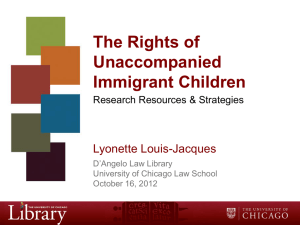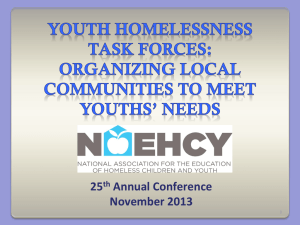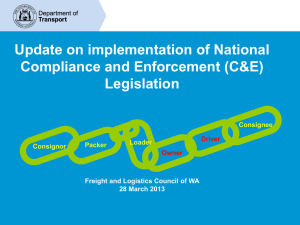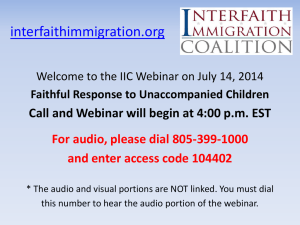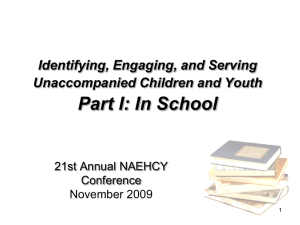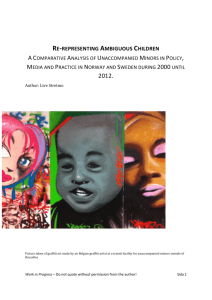Protocol for Enrolling Unaccompanied Youth in School: Whom Do
advertisement
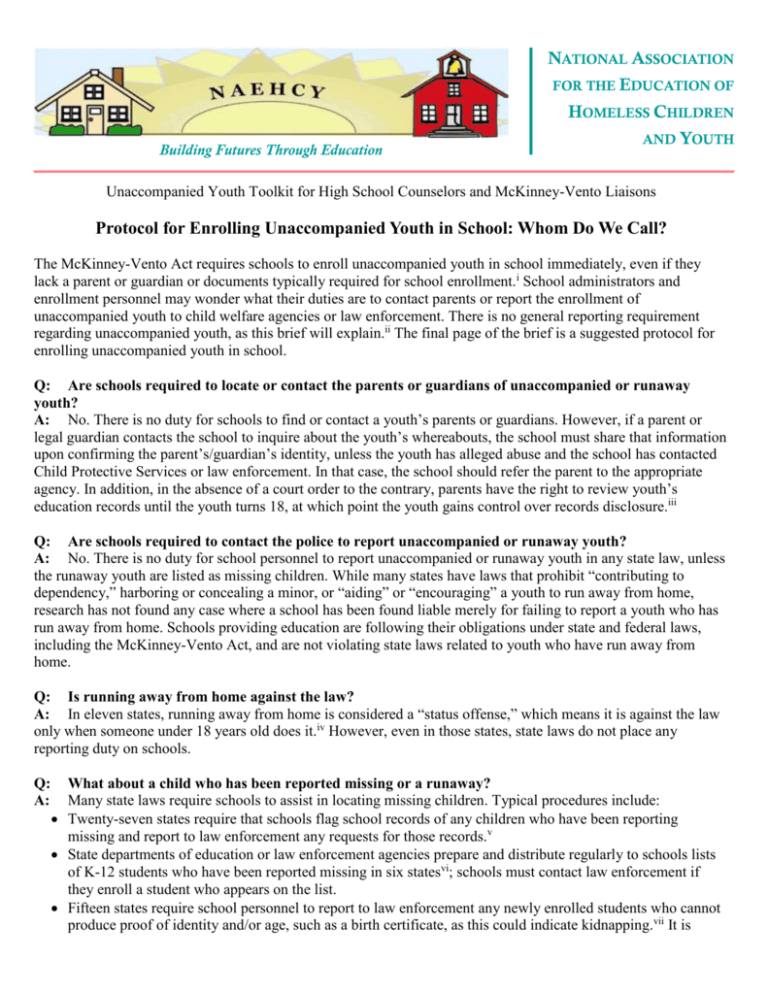
NATIONAL ASSOCIATION FOR THE EDUCATION OF Building Futures Through Education HOMELESS CHILDREN AND YOUTH Unaccompanied Youth Toolkit for High School Counselors and McKinney-Vento Liaisons Protocol for Enrolling Unaccompanied Youth in School: Whom Do We Call? The McKinney-Vento Act requires schools to enroll unaccompanied youth in school immediately, even if they lack a parent or guardian or documents typically required for school enrollment.i School administrators and enrollment personnel may wonder what their duties are to contact parents or report the enrollment of unaccompanied youth to child welfare agencies or law enforcement. There is no general reporting requirement regarding unaccompanied youth, as this brief will explain.ii The final page of the brief is a suggested protocol for enrolling unaccompanied youth in school. Q: Are schools required to locate or contact the parents or guardians of unaccompanied or runaway youth? A: No. There is no duty for schools to find or contact a youth’s parents or guardians. However, if a parent or legal guardian contacts the school to inquire about the youth’s whereabouts, the school must share that information upon confirming the parent’s/guardian’s identity, unless the youth has alleged abuse and the school has contacted Child Protective Services or law enforcement. In that case, the school should refer the parent to the appropriate agency. In addition, in the absence of a court order to the contrary, parents have the right to review youth’s education records until the youth turns 18, at which point the youth gains control over records disclosure.iii Q: Are schools required to contact the police to report unaccompanied or runaway youth? A: No. There is no duty for school personnel to report unaccompanied or runaway youth in any state law, unless the runaway youth are listed as missing children. While many states have laws that prohibit “contributing to dependency,” harboring or concealing a minor, or “aiding” or “encouraging” a youth to run away from home, research has not found any case where a school has been found liable merely for failing to report a youth who has run away from home. Schools providing education are following their obligations under state and federal laws, including the McKinney-Vento Act, and are not violating state laws related to youth who have run away from home. Q: Is running away from home against the law? A: In eleven states, running away from home is considered a “status offense,” which means it is against the law only when someone under 18 years old does it.iv However, even in those states, state laws do not place any reporting duty on schools. Q: A: What about a child who has been reported missing or a runaway? Many state laws require schools to assist in locating missing children. Typical procedures include: Twenty-seven states require that schools flag school records of any children who have been reporting missing and report to law enforcement any requests for those records.v State departments of education or law enforcement agencies prepare and distribute regularly to schools lists of K-12 students who have been reported missing in six statesvi; schools must contact law enforcement if they enroll a student who appears on the list. Fifteen states require school personnel to report to law enforcement any newly enrolled students who cannot produce proof of identity and/or age, such as a birth certificate, as this could indicate kidnapping.vii It is important for schools to keep in mind that these requirements cannot result in any delay or interruption in a homeless youth’s enrollment or attendance. To ensure students have not been reported missing, schools may wish to check with their state missing children clearinghouses or the National Center for Missing & Exploited Children (missingkids.com or 1-800-THE-LOST) after enrolling unaccompanied youth. If a student has been reported missing or a runaway, a school counselor or other appropriate adult should speak with the student to get more information about the youth’s safety, home situation and possible repercussions of returning the youth home. The school should contact the school resource officer, if available. Schools without a resource officer should contact local law enforcement. Q: What if we suspect abuse? A: Almost all states have laws that specifically require school personnel to contact law enforcement and/or Child Protective Services (CPS) if they have reasonable cause to suspect that a child has been abused.viii The fact that a youth has run away from home does not necessarily provide reasonable cause to suspect child abuse. Therefore, people should not automatically report runaway youth under state mandatory reporting laws. Most mandated reporters receive training to help them determine when they must contact CPS. When reporting suspected child abuse, reporters should contact CPS instead of the police, as CPS should have the training and facilities to respond more appropriately to such reports.ix Q: Are there other requirements for adults who provide shelter or housing for unaccompanied youth? A: Yes. Many states have laws that prohibit “contributing to dependency,” harboring or concealing a minor, or “aiding” or “encouraging” a youth to run away from home. A person who provides shelter or housing to an unaccompanied youth, actively hides a child from his or her parents or lies about the child’s whereabouts, or somehow entices a child to leave home, may be violating these laws. To protect themselves from liability, people sheltering unaccompanied youth should discuss with the youth the best course of action, but likely will need to contact the youth’s parents, CPS or law enforcement within a short period of time (often as little as 24 hours). i 42 U.S.C. §11432(g)(3)(C). State-by-state research and information for all the laws discussed in this brief is available at http://naehcy.org/memos.html. For a more complete analysis of state laws, consult legal services in your state. Visit http://www.lsc.gov/ or http://www.ptla.org/legal-services-links for information about legal services in your area. iii Family Educational Rights and Privacy Act (FERPA), 20 USC §1232g; 34 CFR §§99.3, 99.5. iv Those states are: AL, GA, ID, KY, MO, NE, SC, TX, UT, WV and WY. Parental abuse and neglect are likely to be a defense to this status offense. In addition, almost every state allows police or other law enforcement officers to take runaway youth into custody without a court order and without the youth’s permission. Almost all states also offer services to runaway youth and their families, such as counseling, family mediation and alternative placements. These services are offered through a juvenile or family court process commonly called “Child in Need of Supervision” (CHINS), or something similar. v Those states include AK, AZ, AR, CA, FL, ID, IL, IN, KS, KY, ME, MA, MI, MN, MO, NE, NV, NJ, NY, NC, ND, OH, PA, RI, TX, UT and VA. vi Those states include AL, CA, CO, FL, MT and TN. In addition, schools in AL must provide lists of new students on a regular basis to the state missing children’s clearinghouse. vii Those states include ID, IL, IN, KS, KY, MI, MT, NE, NV, NJ, NY, ND, TX, UT and WV. viii For a state-by-state listing of child abuse reporting requirements, see U.S. Department of Health and Human Services, Mandatory Reporting Requirements of Child Abuse and Neglect: Summary of State Laws (April 2010), available at: http://www.childwelfare.gov/systemwide/laws_policies/statutes/manda.pdf. ix Every state’s mandatory reporting law allows for reporting to CPS, except those from KY, NV and TX, which require reporting to law enforcement. ii Nov. 2011 Protocol for Enrolling Unaccompanied Youth in School 1. Enroll unaccompanied youth immediately, as required by the McKinney-Vento Act. 2. Contact your school district McKinney-Vento liaison to inquire about available services and support and to ensure the youth is appropriately entered into the district data system. 3. Welcome the youth to the school: Inform the youth of classes, programs and activities available. Provide a school tour. Offer a peer and adult mentor. Give the youth the opportunity to connect with the school counselor or school resource officer for support. Inform the youth of his/her eligibility for free school meals and other McKinney-Vento services. 4. There is no automatic duty to report the youth to parents, law enforcement or CPS. 5. After enrollment, check with the state missing children clearinghouse or the National Center for Missing & Exploited Children (missingkids.com or 1-800-THE-LOST). If the youth has been reported missing, a school counselor or other appropriate adult should speak with the student to get more information about the youth’s safety, home situation and possible repercussions of returning the youth home. The school should contact the school resource officer, if available. Schools without a resource officer should contact local law enforcement. 6. If you receive a request for records that have been flagged as a missing child, or you receive flagged records from another school, contact law enforcement immediately. 7. If you are contacted by the student’s parent or legal guardian: Confirm the parent’s or legal guardian’s identity. Share information with parents and legal guardians, unless you have a court order to the contrary or the youth has alleged abuse (in which case contact Child Protective Services and refer the parent or guardian to that agency). In cases of family conflict or dysfunction, refer the student and parent to the school counselor, school social worker, local youth-serving agencies or community family mediation resources. 8. If you have reason to suspect child abuse that triggers your duty as a mandated reporter, contact Child Protective Services. All mandated reporters working with unaccompanied youth should tell them up front that they are mandatory reporters, so youth can choose what information to share. Many youth fear the involvement of child welfare services due to past negative experiences with the system, loyalty to parents, or concern for siblings still at home. NAEHCY, Nov. 2011
